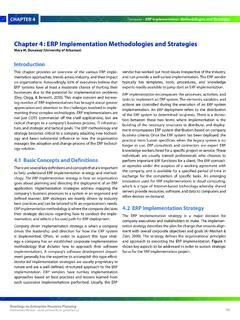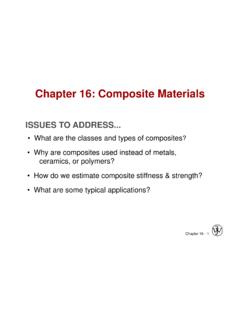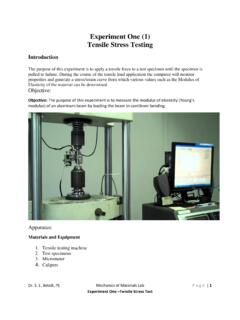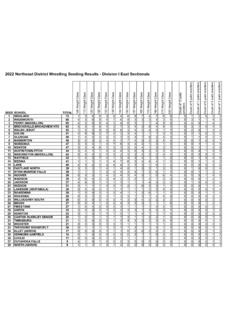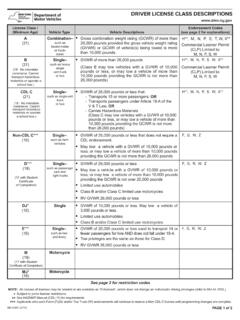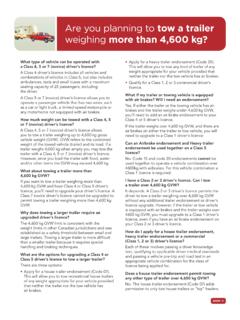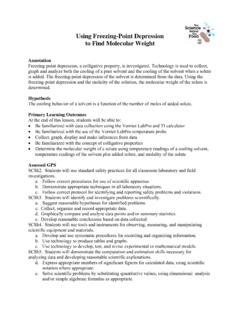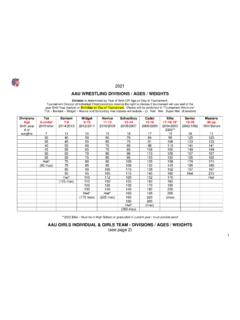Transcription of Milliequivalents, Millimoles, and Milliosmoles
1 Milliequivalents, Millimoles, and Milliosmoles Electrolytes vs Nonelectrolytes Compounds in solution are often referred to as either electrolytes or nonelectrolytes - Electrolytes are compounds that in solution dissociate to varying degrees into ions . which have an electrical charge Examples: NaCl, KCl, MgSO4. - Nonelectrolytes are compounds which do not dissociate in solution Examples: dextrose, urea Cations versus Anions In solution ions move in a direction opposite their charge Cations: positively charged ions - When placed in a solution the ions move to the negative electrode (or the cathode). - Examples: Na+, K+, Ca++, Mg++. Anions: negatively charged ions - When placed in solution the ions move towards the positive electrode (or the anode).
2 - Examples: Cl-, HC03-,S04-, HP04- Terminology Mole= Avogadro's number ( x 1023) of molecules Molecular weight (MW)= weight in grams of one mole of compound Millimoles (mmole)= 1000 x moles - g/mole = mg/mmole Valence= amount of charge of an ion Equivalents (Eq)= number of univalent counter ions needed to react with each molecule of substance - HCl has 1 equivalent per mole in that one mole of H+. reacts with one mole of Cl- Milliequivalent In the United States, the concentration of electrolytes in solution is expressed in terms of milliequivalents (mEq). - EXCEPTION: Phosphorous is usually referred to in terms of mmoles - Note: in Europe concentrations of electrolytes are often expressed in terms of millimoles per liter or micromoles per liter).
3 Refers to the chemical activity of an electrolyte Is related to the total number of ionic charges in solution and considers the valence (charge) of each ion For a given chemical compound, the milliequivalents of cations equals that of anions - Example: a solution of NaCl will contain the same number of milliequivalents of Na+ (the cation) as it will Cl- (the anion). There is a trend to shift from using mEq to using mg of the given ion. Beware that this can be confusing! They are not EQUIVALENT!!! And mg of a given ion is not equivalent to mg of the compound. ( , mEq CaCl2 is not equal to mg CaCl2 which is not equal to mg Ca ion. Milliequivalents mEq = represents amount in milligrams, of a solute equal to 1/1000. of its gram equivalent weight taking into account the valence of the ions.)
4 Equivalent weight = formula weight divided by the total valence mEq = mg x valence atomic, molecular or formula weight mg = mEq x atomic, molecular or formula weight valence Equiv weight (g) = atomic, molecular or formula weight valence Calculations with Milliequivalents Converting millieqivalents to weight Converting weight to milliequivalents Converting mg% to mEq/L. Listing of Atomic Weights, Valences, and Equivalent Weights for Common Ions Atomic/Formula weight Valence Equiv Wt (Atomic/valence). Al+++ 27 3 9. NH4+ 18 1 18. Ca++ 40 2 20. Fe+++ 56 3 Mg++ 24 2 12. K+ 39 1 39. Na+ 23 1 23. C2H303- 59 1 59. HC03- 61 1 61. C03-- 60 2 30. Cl- 1 S04- 96 2 48. Converting Millieqivalents to weight What is the concentration of a solution containing 4 mEq/L of KCl?
5 Step 1: Calculate the molecular weight of KCl MW of potassium (K) = 39. MW of chloride (Cl) = MW KCl = MW K + MW CL = 39 + = g Step 2: Calculate equivalent weight Equiv weight = molecular weight KCl divided by valence Since valence of KCl = 1, Equiv weight = 1. Step 3: 1 mEq KCl = 1/1000 x g = g = mg Step 4: 4 mEq KCl = x 4 = 298 mg/ml OR using the equation listed before: mg = mEq x atomic, molecular or formula weight valence (4 ) = 298mg / ml mg/ml = mEq/ml * atomic, molecular or formula weight =. valence 1. Converting weight to Milliequivalents How many mEq of KCl are in of KCl? Step 1: Calculate the molecular weight of KCl MW of potassium (K) = 39. MW of chloride (Cl) = MW KCl = MW K + MW CL = 39 + = g Step 2: Calculate equivalent weight Equiv weight = molecular weight KCl divided by valence Since valence of KCl = 1, Equiv weight = 1.
6 Step 3: 1 mEq KCl = 1/1000 x g = g = mg Step 4: 1 mEq KCl = mg; g KCl = 1500 mg; How many mEq in 1500 mg? 1mEq =. XmEq 1500mg X = mEq Converting mg% to mEq/L. Convert the expression 10 mg% of Ca++ to mEq/L. Step 1: Calculate the atomic weight of Ca++. Atomic weight of Ca++=40. Step 2: Calculate equivalent weight Equiv weight = molecular weight Ca++ divided by valence Since valence of Ca++ = 2, Equiv weight = 40/2 = 20 g Step 3: 1 mEq Ca++ = 1/1000 x 20 g = g = 20 mg Step 4: 10 mg% Ca++= 10 mg/100ml = 100 mg per liter 20mg 100mg = X = 5 mEq/L. 1mEq XmEq Millimoles Remember: - Molecular weight = g/mole - Millimole = 1/1000 of a mole Key Equation (by definition): g Xg =. mole 1mole Molecular WT (g/m). Conversions to remember: 1 mole = 1000 millimoles g/mole = mg/millimole Millimoles Example Calculating amount - How many milligrams of monobasic sodium phosphate (MW 138) are in 1 millimole g Xg = Since the Molecular Wt is 138.
7 Mole 1mole 138 g Xg X = 138 g in 1 mole Molecular WT (g/m) =. mole 1mole 1 millimole = g = 138 mg Osmolarity vs Osmolality Measures of osmotic concentration Osmolarity: millimoles of solute per liter of solution Osmolality: millimoles of solute per kilogram of solvent Osmolarity is NOT ALWAYS equivalent to Osmolality (beware of terminology!). Osmolarity mOsmol/L = wt of substance (g/L) x number of species x 1000. MW (g). Osmolarity How many Milliosmoles are in 1 liter of 10 mg% Ca++? Remember: mOsmol/L = wt of substance (g/L) x number of species x 1000. MW (g). Step 1: Identify the atomic weight of Ca++ (Atomic weight of Ca++=40). Step 2: 10 mg% Ca++= 10 mg/100ml = 100 mg per liter Step 3: 10 mg% Ca++= 10 mg/100ml = 100 mg per liter= g/L.
8 Step 4: mOsmol/L = (g/L) x 1 x 1000 = mOsm/L. 40 (g). Therefore in each liter of 10mg% of Ca++ there are mOsm Conclusions Simple approaches can be used to convert to amount (or concentration) expressed in metric units such as grams or g/L to mEq, mmoles or mOsm. Pharmacists should understand - The difference between mg (mg/ml), mEq, mmoles and mOsm - How to convert between the various units of measures

